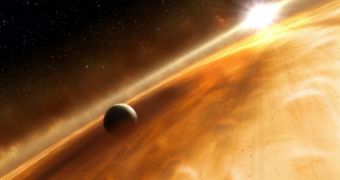German researchers recently published a new study, whose goal was to clear up a mystery related to data observed by telescopes looking for exoplanets. With additional researches in this field, it may soon be possible to gain a deeper understanding of how extrasolar planets form and evolve.
In order to understand the conundrum scientists had to face, it is important to understand that there are two primary methods for discovering exoplanets, the radial velocity method and the transit method.
The former implies telescopes analyzing how stars hosting exoplanets move in their own, tiny orbits around the common center of gravity they share with the other objects in the system. The speed at which the object moves is proportional to changes in its spectral lines due to the Doppler effect.
The transit method is somewhat more direct, as it revolves around detecting faint variations in the brightness of a star, which generally occur when an object passes in between a telescope and the star.
If the brightness varies at constant intervals, then the object causing the dimming is in a stable, periodic orbit around the star, hence most likely a planet. Each of these two methods has its unique capabilities and challenges, Universe Today reports.
What puzzled experts is that the radial velocity approach revealed excess emission in the infrared portion of the electromagnetic spectrum. This was seen as an indicator that the star still had a dust disk around it, or that a Kuiper Belt-like structure existed in the system.
However, when the same stars were studied with the transit method, no such structures were found, even though the target exoplanets themselves were confirmed. German astronomers from the Astrophysikalisches Institut sought to solve this mystery in their new paper.
When the study began, only 93 transiting exoplanets were known, and all were included. Infrared data from telescopes such as IRAS, ISO, AKARI, Spitzer and WISE were used for the research as well.
What the investigation reveals is that it's entirely possible for debris disks to form around stars hosting transiting exoplanets. Of the relevant sample of 52 objects for which both IR and radial velocity data existed, only 2 displayed this characteristic.
In a similar study, another team discovered that 10 out of 150 stars hosting exoplanets displayed debris disks around them. This is the equivalent of 7 percent of all studied objects, as opposed to the 4 percent the latest investigation discovered.
While these studies do leave some questions unanswered, they also set a solid foundation for other follow-up researches to be conducted at a later time. Ultimately, understanding how exoplanets and debris disk coexist may lead to new knowledge of how planets form and evolve over time.

 14 DAY TRIAL //
14 DAY TRIAL //